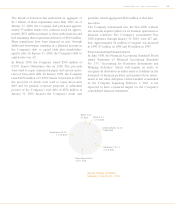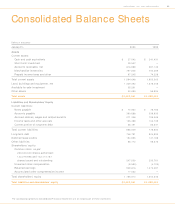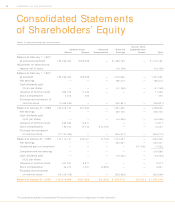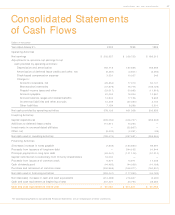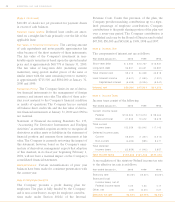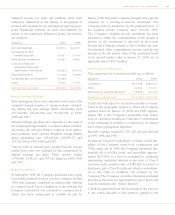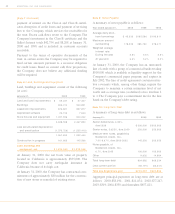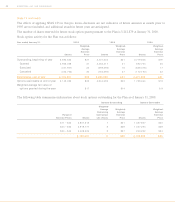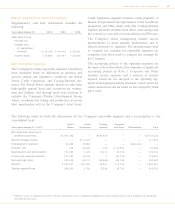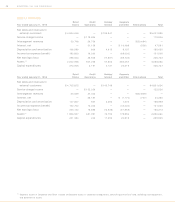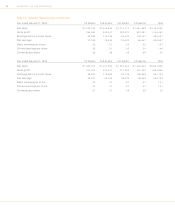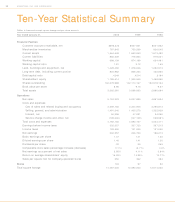Nordstrom 1999 Annual Report Download - page 45
Download and view the complete annual report
Please find page 45 of the 1999 Nordstrom annual report below. You can navigate through the pages in the report by either clicking on the pages listed below, or by using the keyword search tool below to find specific information within the annual report.
43NORDSTROM, INC. AND SUBSIDIARIES
Note 11: Leases
The Company leases land, buildings and equipment
under noncancelable lease agreements with expiration
dates ranging from 2000 to 2080. Certain leases include
renewal provisions at the Company’s option. Most of the
leases provide for additional rentals based upon specific
percentages of sales and require the Company to pay for
certain other costs.
Future minimum lease payments as of January 31, 2000
are as follows: 2000-$52,940; 2001-$52,762; 2002-
$44,050; 2003-$42,092; 2004-$41,010; and thereafter-
$326,281.
The following is a schedule of rent expense:
Year ended January 31 , 2000 1999 1998
Minimum rent:
Store locations $18,794 $ 19,167 $16,869
Offices, warehouses
and equipment 19,926 19,208 17,811
Store locations
percentage rent 7,441 8,603 12,542
Total rent expense $46,161 $46,978 $47,222
Note 12: Stock-Based Compensation
The Company has a stock option plan (the “Plan”)
administered by the Compensation Committee of the
Board of Directors (the “Committee”) under which
stock options, performance share units and restricted
stock may be granted to key employees of the Company.
Stock options are issued at the fair market value of the
stock at the date of grant. O ptions vest over periods rang-
ing from four to eight years, and expire ten years after the
date of grant. In certain circumstances, vesting of some
options may be accelerated.
In addition to option grants each year, in 1999 and 1998
the Committee granted 272,970 and 185,201 perform-
ance share units, respectively, which will vest over three
years if certain financial goals are attained. Employees
may elect to receive common stock or cash upon vesting
of these performance shares.The Committee also granted
30,069 and 180,000 shares of restricted stock in 1999 and
1998 with weighted average fair values of $32.09 and
$27.75, respectively, which vest over five years. No mon-
etary consideration is paid by employees who receive
performance share units or restricted stock.
The Company applies Accounting Principles Board
Opinion No. 25 (“APB 25”) in measuring compensation
costs under the Plan. Accordingly, no compensation cost
has been recognized for stock options because the option
price equals the market price on the date of grant. For
performance share units, compensation expense is
recorded over the performance period based on the fair
market value of the stock at the date it is determined that
such shares have been earned. For restricted stock grants,
compensation expense is based on the market price on
the date of grant and is recorded over the vesting period.
Stock-based compensation expense for 1999, 1998 and
1997 was $3,331, $10,037 and $246, respectively.
In addition to the above, in the fourth quarter of 1999,
N ORD ST RO M .com established an option plan under which
3.4 million options were granted at an option price of
$1.67 per share. Pursuant to APB 25, no compensation
cost has been recognized for the options because
the option price was equal to, or in excess of, the fair
value of N O RD ST RO M .com’s stock on the date of grant.
The options vest over a period of two and one-half to
four years and must be exercised within ten years of the
grant date.
If the Company had elected to follow the measurement
provisions of SFAS No. 123 in accounting for its stock
options, compensation expense would be recognized
based on the fair value of the options at the date of grant.
To estimate compensation expense which would be
recognized under SFAS 123, the Company used the
modified Black-Scholes option-pricing model with the
following weighted-average assumptions for options
granted in 1999, 1998 and 1997, respectively: risk-free
interest rates of 5.7%, 5.2% and 5.4%; expected volatility
factors of .61, .46 and .32; expected dividend yield of 1%
for all years; and expected lives of 5 years for all years.
If SFAS 123 were used to account for the Company’s
stock-based compensation programs, the pro forma net
earnings and earnings per share would be as follows:
Year ended January 31 , 2000 1999 1998
Pro forma net earnings $192,936 $201,499 $183,618
Pro forma basic
earnings per share $1.40 $1.38 $1.18
Pro forma diluted
earnings per share $1.39 $1.37 $1.18


